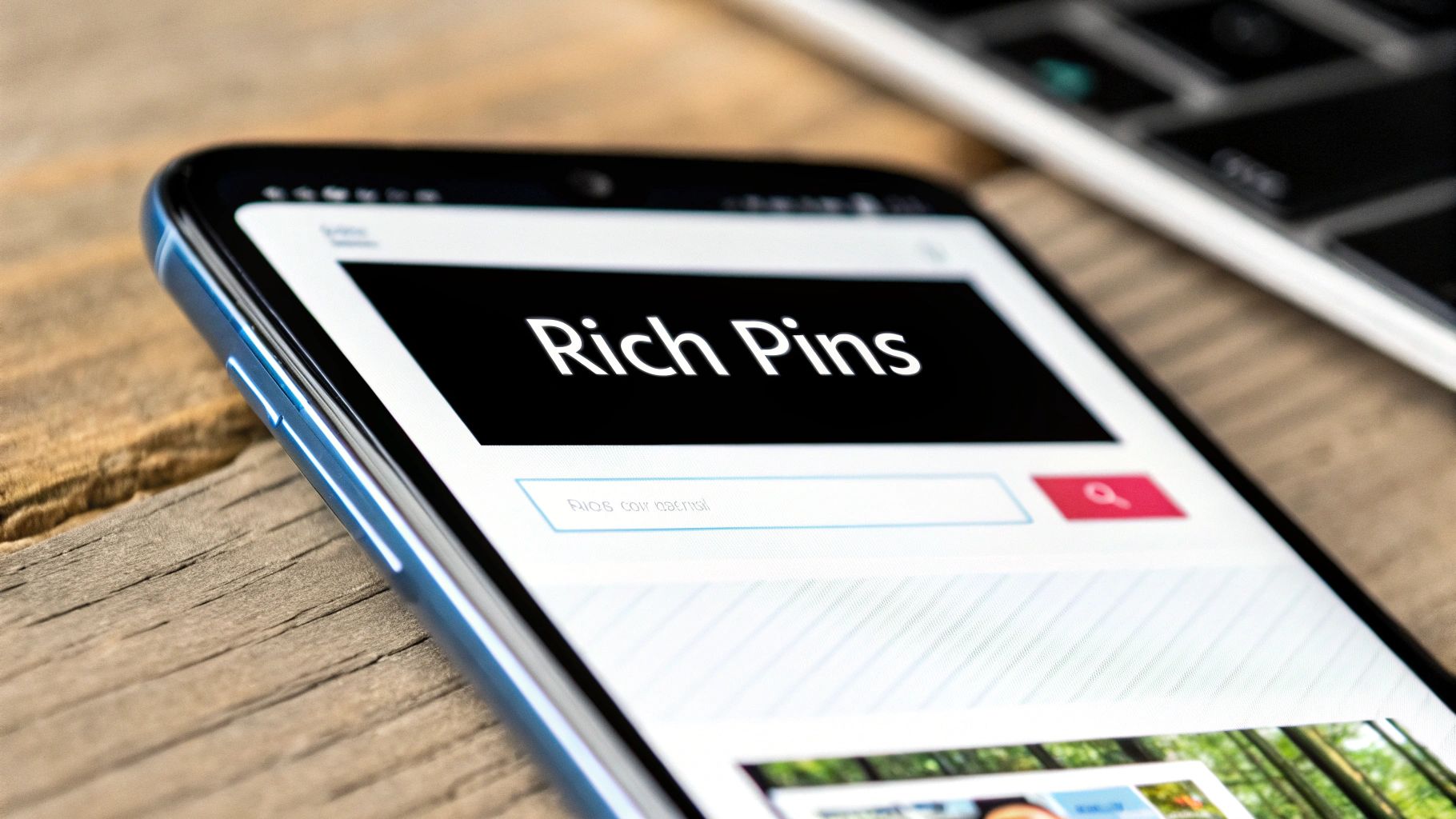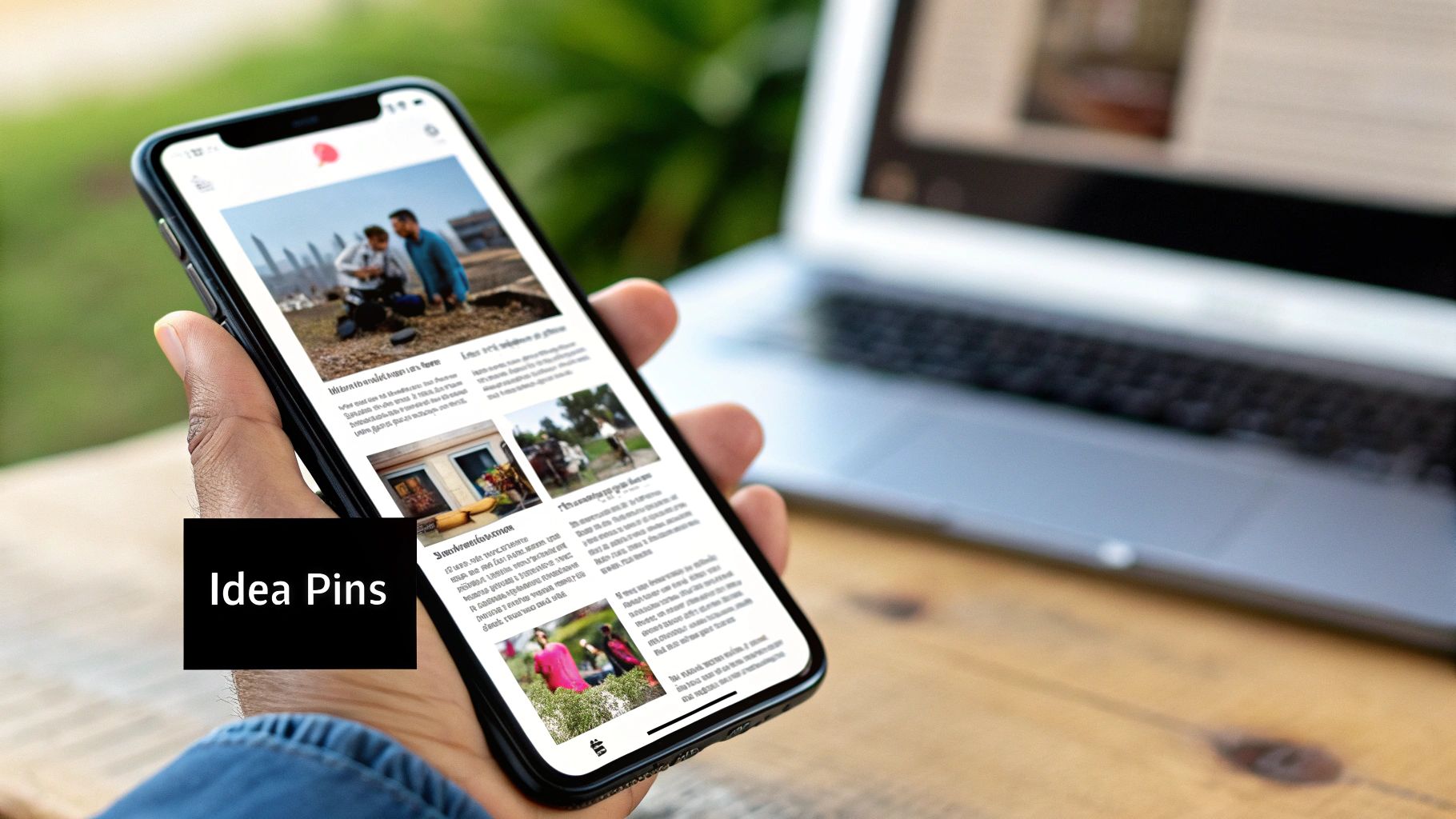8 Advanced Pinterest Growth Strategy Tips for 2025
In 2025, Pinterest has solidified its position not just as a social platform, but as a powerful visual search engine and a crucial e-commerce discovery tool. For creators, bloggers, and businesses, mastering a robust Pinterest growth strategy is no longer optional; it's essential for driving targeted traffic, building brand authority, and boosting sales. With constant algorithm updates and evolving user behavior, the tactics that worked last year may fall flat today.
Generic advice like 'create beautiful pins' simply won't cut it anymore. To truly succeed, you need a multi-faceted approach that combines technical SEO, consistent content creation, strategic engagement, and data-driven optimization. Success on Pinterest isn't about one viral pin, but about building a sustainable system that consistently delivers results. This requires moving beyond surface-level tips and implementing a cohesive, actionable plan.
This article provides a comprehensive roundup of 8 advanced strategies, each a critical component designed to transform your Pinterest presence from a passive mood board into a high-performing marketing channel. We are skipping the fluff to dive deep into the 'how' and 'why' behind each tactic. You will find practical steps, real-world examples, and expert insights to help you implement a winning Pinterest growth strategy immediately. Whether you are a small business owner, a seasoned social media manager, or a blogger looking to amplify reach, these techniques will provide the framework you need for significant growth.
1. SEO-Optimized Pin Descriptions and Board Names
The single most impactful element of any Pinterest growth strategy is treating the platform for what it is: a visual search engine. Unlike other social media feeds where content is fleeting, your Pins can drive traffic for months or even years. To achieve this long-term visibility, you must master Pinterest SEO by optimizing your Pin descriptions, board titles, and profile with relevant keywords. This ensures your content appears when users search for inspiration, ideas, and solutions.

This strategy is fundamental because it directly connects your content with an audience that has high intent. Users on Pinterest are actively looking for things to try, buy, or do. When your Pins are properly optimized, you place your products, services, or blog posts directly in their path at the exact moment they are looking for them.
How to Implement Pinterest SEO
Effective implementation goes beyond just stuffing keywords. It involves weaving them naturally into helpful, compelling copy that encourages users to save, click, and engage.
Actionable Tips for Success
To maximize your organic reach, integrate these practices into your regular pinning routine.
2. Consistent Daily Pinning Schedule
While SEO lays the foundation, consistency is the engine that drives your Pinterest growth strategy forward. Pinterest's algorithm favors active accounts that consistently provide fresh, valuable content to its users. Establishing a regular daily pinning schedule signals to the platform that you are a reliable source of inspiration, which helps boost your visibility in follower feeds, search results, and "More Ideas" sections.

This strategy is crucial because it builds momentum and keeps your audience engaged. Sporadic pinning can lead to dips in traffic and impressions, whereas a steady stream of content ensures your profile remains active and your Pins are continuously distributed. This approach transforms your Pinterest presence from a passive portfolio into a dynamic traffic-generating machine.
How to Implement a Consistent Schedule
Success with this strategy depends on quality and cadence, not just raw volume. The goal is to share a mix of your own new content and relevant, high-quality Pins from other creators to provide constant value to your followers.
Actionable Tips for Success
To maintain a powerful yet manageable schedule, focus on smart distribution and strategic content curation.
3. Rich Pins Implementation
A critical, yet often overlooked, component of a sophisticated Pinterest growth strategy is the activation of Rich Pins. These enhanced Pins automatically sync information directly from your website to your Pins, adding a layer of context and utility that standard Pins lack. By pulling real-time metadata, Rich Pins make your content more actionable, professional, and trustworthy, which directly encourages more saves and, most importantly, more outbound clicks to your site.

This strategy is vital because it significantly improves the user experience. Instead of a user having to click through to find basic information, that data is presented directly on the Pin itself. This added context, whether it's product pricing, recipe ingredients, or an article headline, makes a user more likely to engage with and save your content, signaling to the Pinterest algorithm that your Pins are high-quality and valuable.
How to Implement Rich Pins
Implementation is a one-time technical setup on your website that pays long-term dividends. Once validated, any content pinned from your site will automatically become a Rich Pin. There are four main types you can leverage:
Actionable Tips for Success
To get the most out of this feature, focus on a clean technical setup and ongoing maintenance.
4. Pinterest Advertising and Promoted Pins
While organic reach is the foundation of a strong Pinterest growth strategy, paid promotion is the accelerator. Pinterest Advertising, through its Promoted Pins feature, allows you to boost your best content, reach highly targeted audiences, and drive specific actions far more quickly than organic efforts alone. By investing in ads, you can guarantee visibility for your most important Pins, ensuring they are seen by users who are actively searching for products, services, and ideas just like yours.

This strategy is powerful because it allows you to get in front of your ideal customer with precision. Unlike other platforms where ads can feel interruptive, Pinterest ads are integrated seamlessly into the user's discovery experience. Brands can leverage various ad formats like Standard Pins, Video Pins, Carousel Ads, and Shopping Ads to achieve goals ranging from brand awareness and website traffic to direct sales and lead generation.
How to Implement Pinterest Advertising
Successfully implementing Pinterest ads involves a strategic approach to targeting, creative, and budgeting. You must align your campaign objectives with the right ad format and audience to maximize your return on ad spend.
Actionable Tips for Success
To get the most out of your advertising budget, approach your campaigns with a plan for testing and optimization.
5. Leverage the Power of Video Pins
An essential component of any modern Pinterest growth strategy is embracing video content. Video Pins are dynamic, eye-catching, and receive preferential treatment from the Pinterest algorithm, leading to higher engagement and reach. Unlike static images, videos autoplay in the feed, immediately capturing user attention and telling a more complete story in a short amount of time. This format is incredibly effective for tutorials, demonstrations, and storytelling.
This strategy is powerful because it stops the scroll. A moving Pin stands out in a sea of static images, encouraging users to pause, watch, and engage. Brands like Tasty have built massive followings by creating short, satisfying recipe videos that are highly shareable and saveable. This approach works across countless niches, from DIY craft tutorials showing a process from start to finish to fashion brands showcasing outfit combinations in motion.
How to Implement a Video Pin Strategy
Success with Video Pins requires a different approach than static content. The goal is to deliver value quickly and visually, with or without sound.
Actionable Tips for Success
To maximize the impact of your Video Pins, optimize them for the platform's unique viewing environment.
6. Story Pins and Fresh Content Creation
A powerful component of any modern Pinterest growth strategy involves prioritizing the creation of fresh content, especially through Pinterest's native immersive format, Idea Pins (formerly Story Pins). Idea Pins are multi-page video or image carousels that allow you to create step-by-step guides, tutorials, and behind-the-scenes narratives directly on the platform. The Pinterest algorithm heavily favors this format because it keeps users engaged on the app longer, rewarding creators who use it with significant organic reach.
This strategy is crucial because it taps into user behavior that favors discovery and learning. By providing value upfront within the Pin itself, you build authority and brand loyalty. For instance, a chef breaking down a complex recipe into simple, visual steps in an Idea Pin is more likely to earn a follow than a static image linking to a blog post, as the user receives immediate value.
How to Implement Idea Pins
Successful Idea Pins tell a compelling story. They should have a clear beginning, middle, and end, guiding the user through a process or narrative in a visually appealing way.
Actionable Tips for Success
To get the most out of Idea Pins and fresh content, integrate these practices into your content calendar.
7. Pinterest Analytics and Data-Driven Optimization
An effective Pinterest growth strategy is not built on guesswork; it's built on data. By consistently analyzing your performance, you can move from creating content you think your audience wants to creating content you know they engage with. Pinterest Analytics provides a treasure trove of information about your audience, your top-performing Pins, and the content formats that drive the most engagement, allowing you to refine your approach for maximum impact.
This data-driven optimization is crucial because it eliminates wasted effort. Instead of blindly pinning, you can identify precisely what works and double down on it. For example, data might reveal that your recipe Pins with "quick" in the title get three times more saves or that your vertical video Pins outperform square image Pins by a significant margin. This insight allows you to strategically allocate your creative resources to activities that yield the highest return.
How to Implement Data-Driven Optimization
The key to this strategy is turning raw data into actionable insights. This involves regularly reviewing your analytics dashboard and asking critical questions about your content's performance and your audience's behavior.
Actionable Tips for Success
Incorporate data analysis into your weekly workflow to stay agile and responsive to audience preferences.